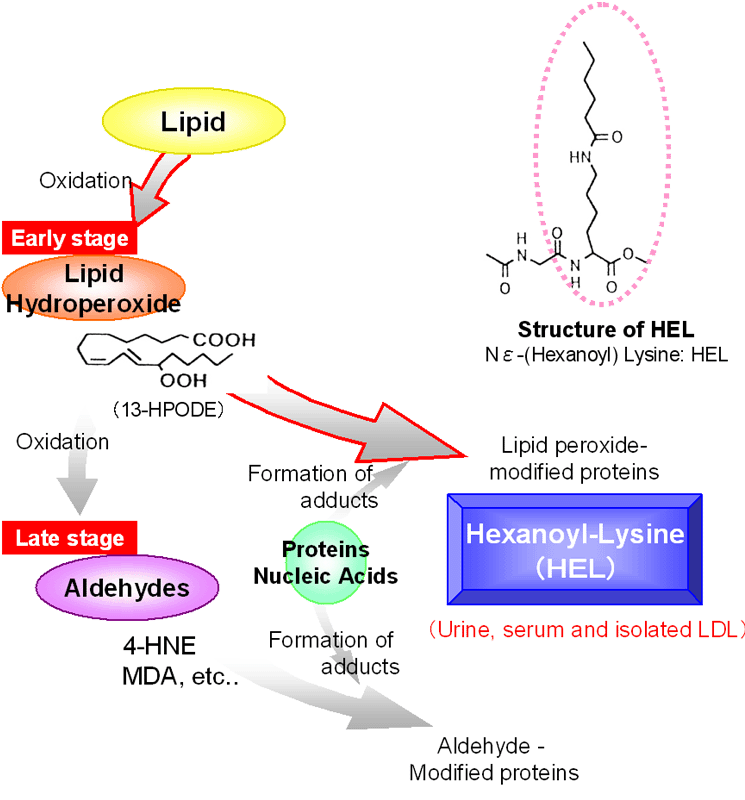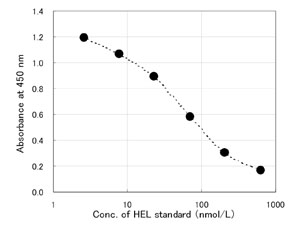
 |
|
Suitable for assessment of oxidative stress using urine, serum and cultured cells. For research use only. |
| What is HEXANOYL-LYSINE ? |
 Biomarker for early stage of lipid oxidation
Oxidative damage of lipids caused by reactive oxygen species (ROS) play an important role in some diseases, lesion of cell functions and aging.
Aldehydes such as malondi-aldehyde (MDA) and 4-hydroxy-2-nonenal (4-HNE) have been reported as one of the advanced lipid peroxidation products.
But recently in the earlier stage of lipid peroxidation, 13-hydroperoxyoctadecanoic acid (13-HPODE) is found to be covalently bound to proteins1).
Hexanoyl-Lysine adduct (HEL) is a novel lipid hydroperoxide-modified lysine residues. HEL is formed by oxidative modification by oxidized omega-6
fatty acids such as linoleic acid or arachidonic acid. HEL may be a useful biomarker for initial stage of lipid peroxidation.Monoclonal antibodies
and ELISA kit have been developped, and HEL can be detected in oxidatively modified LDL, in human atherosclerotic lesions, human urine and serum.
It is also reported that HEL is formed in rat muscle during exercise, and the formation is prohibited by antioxidants such as flavonoids.
|
|
Hexanoyl-Lys (HEL) ELISA kit
JaICA have developed HEL ELISA kit in collaboration with Dr. Toshihiko Osawa (Nagoya University) and Dr. Yoji Kato (Univerisity of Hyogo).
This ELISA kit can be applied to urine, serum and cultured cells form human and animal.
|
|
 |
| Specifications |
| Assay principle: |
Competitive ELISA (detection: 450 nm) |
| Specifity: |
Specific to N-epsilon-Hexanoyl-Lysine adduct |
| Measuring range: |
2 - 700 nmol/L |
| Time to answer: |
Over night and 2 hours. |
| Format: |
96 wells (54 samples in single assay) |
| Applications: |
Urine, serum and cultured cells from human and animals. |
| Storage: |
Store at 2 - 8°C (don't freeze). |
| Expiry: |
2 years after the day of manufacturing. |
| Required but not provided: |
50 µL micropipettor and pipette tips
8-channel (50-200 µL) micropipettor and tips
8 or 12-syncronous multichannel pipet and reagent tray for multichannel pipet.
4-7 °C incubator
Microtiter plate reader (measuring wavelength 450 nm) |
|
 |
| Content of this kit |
| HEL-coated Microtiter Plate: |
1 plate (96 wells) |
| Primary Antibody (ready to use): |
1 vial |
| Secondary Antibody: |
1 vial |
| Secondary Antibody Buffer: |
1 vial |
| Chromogen (TMBZ solution): |
1 vial |
| Chromogen Buffer: |
1 vial |
| Washing Buffer (5X): |
1 vial |
| Stop Solution: |
1 vial |
| Standard solution (6 levels): |
1 vial each |
| Plate seal: |
2 sheets |
|
 |
| References |
| 1) |
Yoji Kato, Yoko Mori, Yuko Makino, Yasujiro Morimitsu, Sadayuki Hiroi, Toshitsugu Ishikawa,
Toshihiko Osawa, Formation of N epsilon-(hexanonyl) lysine in protein exposed to lipid hydroperoxide.
J Biol Chem 274(29), p20406-20414 (1999)
Identification of HEL, which is lysine adduct of 13-HPODE.
|
| 2) |
Yoji Kato, Toshihiko Osawa: Detection of lipid hydroperoxide-derived protein modification with
polyclonal antibodies. Methods in Molecular Biology, vol. 186,
Oxidative stress biomarkers and antioxidant protocols, D Armstrong, Ed., Human Press Inc., NJ, USA, p37-44
Immunohistochemical detection of hexanoyl-lysine adduct.
|
| 3) |
Kato Y, Miyake Y, Yamamoto K, Shimomura Y, Ochi H, Mori Y, Osawa T,
Preparation of a monoclonal antibody to N(epsilon)-(Hexanonyl)lysine: application to the evaluation of protective effects
of flavonoid supplementation against exercise-induced oxidative stress in rat skeletal muscle.
Biochem Biophys Res Commun 274(2),p389-393(2000)
Development and characterization of anti HEL monoclonal antibody. |
| 4) |
Ryo K, Yamada H, Nakagawa Y, Tai Y, Obara K, Inoue H, Mishima K, Saito I,
Possible involvement of oxidative stress in salivary gland of patients with Sjogren's syndrome.
Pathobiology 73(5), p252-260 (2006)
HEL can be detected in saliva samples from patients with Sjogren's syndrome. |
| 5) |
Suzuki T, Kazui T, Yamamoto S, Washiyama N, Ohkura K, Ohishi K, Bashar AH, Yamashita K, Terada H,
Suzuki K, Akuzawa S, Fujie M,
Effect of prophylactically administered edaravone during antegrade cerebral perfusion in a canine model of old cerebral infarction.
J Thorac Cardiovasc Surg 133(3),p710-716 (2007)
Application to canine serum samples. |
| 6) |
Shimizu K, Ogawa F, Akiyama Y, Muroi E, Yoshizaki A, Iwata Y, Komura K, Bae S, Sato S,
Increased Serum Levels of N(epsilon)-(hexanoyl)lysine, A New Marker of Oxidative Stress, in Systemic Sclerosis.
J Rheumatol. 2008 Sep 1.
Serum HEL concentration from systemic sclerosis is higher than that from healthy subjects. |
| 7) |
Tamura H, Takasaki A, Miwa I, Taniguchi K, Maekawa R, Asada H, Taketani T, Matsuoka A, Yamagata Y,
Shimamura K, Morioka H, Ishikawa H, Reiter RJ, Sugino N,
Oxidative stress impairs oocyte quality and melatonin protects oocytes from free radical damage and improves fertilization rate.
J Pineal Res 44(3),p280-287(2008)
Intrafollicular concentration of HEL was significantly reduced by these antioxidant treatment. |
| 8) |
Sakamoto Y, Ishikawa T, Kondo Y, Yamaguchi K, Fujisawa M,
The assessment of oxidative stress in infertile patients with varicocele. BJU Int 101(12), p1547-1552 (2008)
Azoospermic and oligospermic patients had a significantly higher HEL concentration in seminal plasma. |
| 9) |
Kageyama Y, Takahashi M, Nagafusa T, Torikai E, Nagano A,
Etanercept reduces the oxidative stress marker levels in patients with rheumatoid arthritis. Rheumatol Int 28(3),pp245-251(2008)
Urinary HEL level was reduced at 3 and 6 months after the initial treatment with etanercept. |
| 10) |
Rummenie VT, Matsumoto Y, Dogru M, Wang Y, Hu Y, Ward SK, Igarashi A, Wakamatsu T, Ibrahim O, Goto E,
Luyten G, Inoue H, Saito I, Shimazaki J, Tsubota K,
Tear cytokine and ocular surface alterations following brief passive cigarette smoke exposure. Cytokine 43(2),p200-208(2008)
HEL concentration in tear was increased by brief passive exposure to cigarette smoke. |
| 11) |
K Sakai, S Kino, A Masuda, M Takeuchi, T Ochi, J Osredkar, B Rejc, K Gersak, N Ramarathnam, Y Kato;
Determination of HEL (Hexanoyl-Lysine Adduct): A Novel Biomarker for Omega-6 PUFA Oxidation.
Lipid Hydroperoxide-Derived Modification of Biomolecules: Subcellular Biochemistry 77,p61-72(2014)
An original paper for HEL ELISA development. |
|
 |
| Product name |
Code |
Assay range |
Application |
| Hexanoyl-Lys (HEL) ELISA |
KHL-700E |
2-700 nmol/L |
Urine, serum, cultured cells and other biological materials |
|
Made in Japan. |
|
|
How to order
|
|
|
| Contact technical support |
|
|
[NOTICE]: Our products are for RESEARCH USE ONLY. Not for diagnostic, medical or other use.
We are making efforts to prevent errors or mistakes on preparing web site documents, instruction manuals and products.
But even if some damage would be caused by such faults, we will be exempt from responsibility.
|
Copyright ©
Genox Corporation. All rights reserved.
|






 )
)